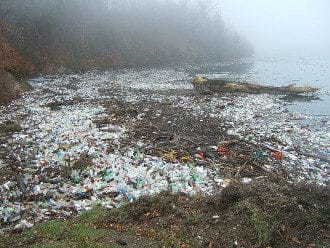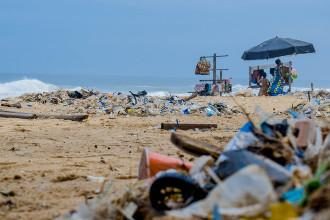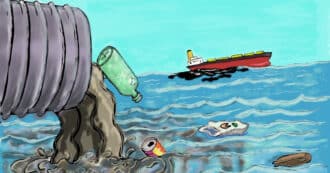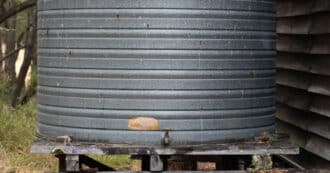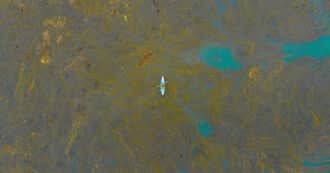By Sydney Cohen – There’s a lot of plastic in the ocean. In fact, it’s estimated that there are more than 5 trillion pieces of plastic in the world’s oceans. This is not only harmful to marine ecosystems, but also to humans as we rely on the ocean for food and other resources. Thankfully, there are people and organizations who are working to clean up the ocean and reduce the amount of plastic that ends up in it.
We must make an effort to reduce our plastic pollution problem, to prevent floating ocean plastic and further harm to the food chain. There are many public ocean cleanup plans to remove plastic and clean plastic trash from the ocean surface and reduce these harmful garbage patches. Continue reading to learn more about the plastic waste that leads to floating ocean plastic islands and ways that you can get involved in ocean cleanup efforts!
Plastic Pollution Problem
The plastic pollution problem in our oceans is a huge problem that must be addressed. Every day, 8 million tons of plastic end up on our ocean’s surface. This is causing serious damage to marine life and the environment. And the problem is only getting worse. Plastic pollution is a global issue, and it’s time we did something about it.
Most of the plastic that is in the ocean arrives via rivers, goes into marine garbage and becomes stuck by the ocean currents and wind that pass around the sea. Unless the problem is solved, the trash, plastics of various sizes, micro plastics, plastic debris, and marine debris will negatively affect ecosystem health.
Often, discarded fishing gear ends up as part of the debris found on the shore and in the open ocean. It is incredibly necessary that we minimize the human waste that is contributing to the trash wheel, as our waste only allows it to grow, further endangering our environment and marine ecosystems.
The Great Pacific Garbage Patch
Did you know that there is a huge patch of plastic garbage floating in the ocean? It’s called the Great Pacific Garbage Patch, and it’s twice the size of Texas! This pollution is harming marine life and making our oceans increasingly uninhabitable.
According to The Ocean Cleanup’s website, “The Great Pacific Garbage Patch (GPGP) is the largest of the five offshore plastic accumulation zones in the world’s oceans. It is located halfway between Hawaii and California”. All of the plastic swirling in the sea makes its way into garbage patches throughout the oceans. These large patches, or trash wheels, prevent marine life from thriving.
Ocean Cleanup Solutions
A recent study found that there are more than 5 trillion pieces of plastic in the world’s oceans. That’s a lot of plastic! And it’s not just floating on the surface – 92% of all plastic is located underwater, where it can be detrimental to marine life. So what can we do to clean up our oceans? There are a number of initiatives underway, but we need everyone’s help to make a difference.
Some ocean species can actually help us collect trash. Jellyfish are one of the species of marine life that can aid in reducing human pollution. According to Planet Home, “Jellyfish mucus has an absorbing property that can catch microplastics that are present in water. These plastics are not visible to the eye and aren’t caught by seawater treatment plants due to their small size, so they enter our system and harm our health.”.
It is fascinating that though our trash is preventing so many species from thriving in the ocean, a few species can naturally help with ocean cleanups. While the major solution would be to stop polluting our oceans with trash, it is good to know that some species are able to help, without facing harm themselves.
Innovative Cleanup Technologies
Fortunately, there are many forms of innovative technologies entering the market to aid in removing plastic from our waterways and even preventing plastic from entering oceans in the first place.
The non-profit Hawaii Wildlife Fund noticed that microplastics were harming the ecosystems onshore. Their design team worked on creating a machine known as the Hoola One, which “sucks a mixture of sand and plastic into a tank that separates particles by weight, so plastic can be filtered out. Clean sand and rocks weigh more and sink to the bottom, where they can be returned to the beach. The machine processes around three gallons of sand a minute”.
However, scientist George Leonard notes that “if you really want to solve this problem, you need to solve this problem way farther upstream, before these materials ever get to the ocean”. Fortunately, there are other non-profits working to tackle this problem, using other tools.
The Ocean Cleanup – A Non-Profit with a Solution
“Ocean Cleanup” is a non-profit organization in the Netherlands developing technology to remove plastic pollution from the oceans by intercepting it in water. They aim to eliminate plastic waste from our seas. The company’s prototypes were tested and deployed in the North Sea, before deploying the first full-scale prototype in a Great Pacific trash heap.
Boyan Slat, founder of the non-profit, “proposed using that movement [of ocean currents] as an advantage: With a barrier in the water, he argued, the swirling plastic could be collected much more quickly. Then it could be pulled out of the water and recycled”. The Ocean Cleanup’s ambitious plans have been featured in Hakai Magazine (article by Ryan Stuart) and USA Today.
The Ocean Cleanup’s mission is to rid oceans of plastic debris, reduce the accumulation of plastic that leads to the formation of trash wheels, and reduce the size of the Great Pacific Garbage Patch, in the north pacific ocean through various cleanup systems. They work to develop methods of removing plastic that will actually work, in order to protect our marine ecosystems from further plastic accumulation.
Ocean Cleanup’s Technologies
Ocean Cleanup’s technology to remove floating plastic works by harnessing “the currents and the wind to herd the bigger floating pieces of plastic into horseshoe-shaped booms. Just as windblown trash gets ensnared in a fence, the plastic should get trapped in the booms until a boat can come to haul the debris to shore”. With their booms, they can collect plastics, such as plastic bags, and other larger pieces of debris that grow trash patches.
In addition to these booms, “The Ocean Cleanup plans to roll out new devices called “Interceptors” that aim to trap waste in rivers before they enter the ocean. The solar-powered contraptions, which closely resemble a boat, use a long barrier to direct waste towards a conveyor belt that drops all the debris into dumpsters”. With the combined two systems of the booms in the ocean and the river interceptors, The Ocean Cleanup plans to target the whole problem of plastic in our waterways.
However, The Ocean Cleanup’s plans have unfortunately faced various difficulties since 2018. Additionally, species such as sail jellyfish and other neuston species that drift with the winds and currents are potentially at risk by the booms that The Ocean Cleanup plans to deploy.
Furthermore, “while there is plenty of plastic floating on the surface of the North Pacific gyre, even more is out of reach, suspended in the water column and degraded into tiny pieces that slip right through the booms”. Nonetheless, The Ocean Cleanup maintains its ambitious plans and is continuing to develop its innovative technologies. In 2021, The Ocean Cleanup announced that they have partnered with Coca-Cola to further develop and implement their cleanup system.
Religion and The Ocean
Interfaith Oceans is an organization that brings together diverse faith groups to protect the ocean systems and species. Interfaith Oceans works to cultivate knowledge about ocean issues and faith perspectives, awaken others through spreading this information, and to take action through prayer, discussion, lobbying and other activities. On their website is a variety of faith-based organizations and resources to address ocean issues, including a quote from Ecumenical Patriarch Bartholomew who remarks: “So what we do to the oceans, God’s vast blue Creation, we do to God’s other creations, including ourselves. . . .”
The ocean is not some place “out there” that we can dump all our garbage without worrying about the consequences. The ocean is a key part of planet Earth, vital for the functioning of life above and below the sea, so let’s stop polluting and start cleaning.
*Featured image source


